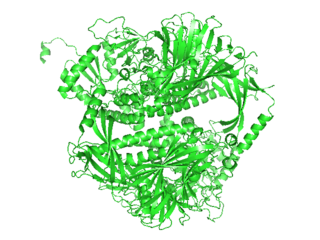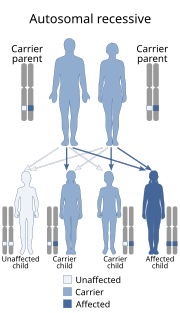
Calnexin (CNX) is a 67kDa integral protein of the endoplasmic reticulum (ER). It consists of a large N-terminal calcium-binding lumenal domain, a single transmembrane helix and a short, acidic cytoplasmic tail.

alpha-Mannosidase is an enzyme involved in the cleavage of the alpha form of mannose. Its systematic name is alpha-D-mannoside mannohydrolase.

Endoplasmic-reticulum-associated protein degradation (ERAD) designates a cellular pathway which targets misfolded proteins of the endoplasmic reticulum for ubiquitination and subsequent degradation by a protein-degrading complex, called the proteasome.
The enzyme Endoglycosidase H is an enzyme with systematic name glycopeptide-D-mannosyl-N4-(N-acetyl-D-glucosaminyl)2-asparagine 1,4-N-acetyl-beta-glucosaminohydrolase. It is a highly specific endoglycosidase which cleaves asparagine-linked mannose rich oligosaccharides, but not highly processed complex oligosaccharides from glycoproteins. It is used for research purposes to deglycosylate glycoproteins.

Endoplasmic reticulum mannosyl-oligosaccharide 1,2-alpha-mannosidase is an enzyme that in humans is encoded by the MAN1B1 gene.

Alpha-mannosidase 2 is an enzyme that in humans is encoded by the MAN2A1 gene.

Glycoprotein endo-alpha-1,2-mannosidase is an enzyme that in humans is encoded by the MANEA gene.

Epididymis-specific alpha-mannosidase is an enzyme that in humans is encoded by the MAN2B2 gene.

Mannosyl-oligosaccharide 1,2-alpha-mannosidase IA is an enzyme that in humans is encoded by the MAN1A1 gene.

ER degradation-enhancing alpha-mannosidase-like 3 is an enzyme that in humans is encoded by the EDEM3 gene.

Beta-mannosidase is an enzyme with systematic name beta-D-mannoside mannohydrolase, which is in humans encoded by the MANBA gene. This enzyme catalyses the following chemical reaction

Beta-mannosidosis, also called lysosomal beta-mannosidase deficiency, is a disorder of oligosaccharide metabolism caused by decreased activity of the enzyme beta-mannosidase. This enzyme is coded for by the gene MANBA, located at 4q22-25. Beta-mannosidosis is inherited in an autosomal recessive manner. Affected individuals appear normal at birth, and can have a variable clinical presentation. Infantile onset forms show severe neurodegeneration, while some children have intellectual disability. Hearing loss and angiokeratomas are common features of the disease.

Mannosyl-oligosaccharide 1,2-alpha-mannosidase IB is an enzyme that in humans is encoded by the MAN1A2 gene.
Congenital dyserythropoietic anemia type II, or hereditary erythroblastic multinuclearity with positive acidified serum lysis test (HEMPAS) is a rare genetic anemia in humans characterized by hereditary erythroblastic multinuclearity with positive acidified serum lysis test.
Mannosyl-oligosaccharide 1,2-alpha-mannosidase is an enzyme with systematic name 2-alpha-mannosyl-oligosaccharide alpha-D-mannohydrolase. This enzyme catalyses the following chemical reaction
Mannosyl-oligosaccharide 1,3-1,6-alpha-mannosidase is an enzyme with systematic name (1->3)-(1->6)-mannosyl-oligosaccharide alpha-D-mannohydrolase. This enzyme catalyses the following chemical reaction
Glycoprotein endo-alpha-1,2-mannosidase is an enzyme with systematic name glycoprotein glucosylmannohydrolase. This enzyme catalyses the following chemical reaction
Mannosylglycoprotein endo-beta-mannosidase is an enzyme. This enzyme catalyses the following chemical reaction:

Kifunensine is an alkaloid originally isolated from Kitasatosporia kifunense, an actinobacterium. It is a neutral, stable compound.











